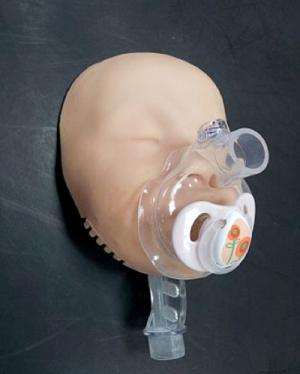A breakthrough in inhalation masks for infants

Researchers at the Technion-Israel Institute of Technology have made a breakthrough that could lead to radical changes in the design and effectiveness of inhalation masks for infants.
Until now, infants' inhalation masks have been miniature versions of adult ones. Since very small children's faces contain features that are different in their relative proportions from those of adults, the masks currently in use often fit poorly, with serious gaps between the mask and the infant's face. This leads to treatment deficiencies, since dosages of medicine, when exposed to air, lose their therapeutic function. Ill-fitting masks also cause discomfort to the wearer.
Through the use of computational metric geometry for facial analysis, Prof. Ron Kimmel from the Faculty of Computer Science, a specialist in computer vision, and Prof. Israel Amirav from Bar-Ilan University, a pediatrician who specializes in lung medicine at Safed's Ziv Hospital, have created an infant-specific inhalation mask. The new mask even contains a small valve chamber that allows for a pacifier to be stuck in the child's mouth while he/she is wearing the mask. The child's suckling serves a dual purpose – it soothes the child, and provides atmospheric pressure on the mask to provide better adhesion. The doctors can then infuse the treatment through another valve, and the child properly inhales the treatment drug in aerosol spray form.
Conceived of by Prof. Amirav and his colleague Asaf Halamish, the project was "important and challenging … and relevant to our field which is the analysis of geometrical shapes," says Prof. Kimmel, who is also the founder and head of the Technion's Geometric Image Processing Laboratory (GIP). Dan Raviv, then a doctoral student (and now a postdoctoral fellow at MIT), and Yaron Honen and Alon Zvirin, both Engineers at the GIP, were also part of the research team.
Using 3-dimensional scanners provided by the GIP, medical staff collected 3D facial images of as many infants as possible, in order to "…get the face shape and size," said Prof. Amirav. The researchers even approached kindergartens and asked for parents willing to let their children participate – resulting in more than 300 3D images that were acquired.
According to Prof. Kimmel, facial recognition systems work best when they are provided with a combination of the 3D information and actual photos. Using related tools, the researchers defined possible classifications in the 3D structure of the facial surface, and characterized them into three main categories. "Each of these categories has a 'median facial model' – representing the most common characteristics of that group," he said.
The researchers then selected the features farthest from the median facial model (in terms of geometric variants) in each category, and made sure the mask would also work with those exceptions. After careful adjustment and an analysis of the results, 3D images were printed and tested. By printing 3D images of the tracheal system (i.e. windpipe), and assembling a perfect model of the respiratory system, the team was also able to determine the quality of insulation, even when making adjustments to account for exceptions.
The FDA has already approved the new mask, and there is a company in the process of producing it for commercial use.





















